A lot of people love to accessorize and personalize their cars. Whether it’s a vanity license plate, bumper stickers, a fuzzy neon steering wheel cover, a smiley face stuck on top of the antenna, or some Mardi Gras beads hanging from the rearview mirror, there are plenty of methods – both tacky and classy – for dressing up your vehicle a bit. (In all honesty, most of them tend towards the tacky, and I’m not excepting myself. I have bright green Mardi Gras beads hanging from my rearview mirror, but at least I put away the fuzzy dice a while ago.)
With some skill and creativity, however, there are ways to make your car unique in a not only classy but authentic-looking manner. Russell Singer, design director at MAKEiT, Inc., has plenty of skill and creativity, and he’s willing to share it. Founded in Pasadena, California in 2014, MAKEiT specializes in industrial desktop 3D printers; Singer, who holds degrees in industrial and systems design, joined the company after working as a research fellow at NASA’s Jet Propulsion Laboratory. Recently, he began a blog called The First Layer as part of the MAKEiT website, where he dedicates time and space to offering 3D printing tips and projects.
Project Number One: a lovely Mini Cooper enhancement in the form of a 3D printed, wood-finished shift knob for his car’s manual gear shift. It’s a pretty specific project, but I suspect that with some skill in 3D design and/or scanning, it can be adapted for any stick shift-bearing car.
“Because the shift knob is a regular point of tactile interaction it was important to achieve not only a high quality finish that would appear as wood, but also a comfortable form with enjoyable tactile feedback and functional usability,” he says. “Aside from preferences on shift knob weight and profile, the only real functional consideration is getting a snug secure fit on the shifter shaft. After one attempt with a simpler friction-fit design, I found the hot daytime temperatures in Southern California would cause enough size distortion to loosen the knob even though it might be very stuck in place in cooler temperatures. I revised the design to work with set screws and some hex nuts that are enclosed into the print.”
 Encapsulating the hex nuts into the print involved a bit of deft maneuvering that involved stopping the print job, quickly inserting the hardware, and resuming the print. Singer decided to do this by hand, although he states that certain slicing software plugins, such as PauseAtZ or TweakAtZ in Cura, will program the pause in for you.
Encapsulating the hex nuts into the print involved a bit of deft maneuvering that involved stopping the print job, quickly inserting the hardware, and resuming the print. Singer decided to do this by hand, although he states that certain slicing software plugins, such as PauseAtZ or TweakAtZ in Cura, will program the pause in for you.
Three cap screws were threaded into place after the part finished printing, and then it was time for the fun part – making the knob look pretty. Singer played around with a few different materials before settling on a wood filament from Hatchbox. For an authentic wooden look, he switched his printer nozzle to a 0.6mm diameter so that the final print came out rough and uneven-looking. For an added touch, he set up the print in Simplify3D so that the print resolution changed several times mid-print, from 0.35mm to 0.075mm, resulting in a nice, natural look.
For the finishing process, Singer recommends any water-based wood stain, applied in three coats with a round of sanding between each one. Several coats of shellac made his stained part glossy and well-sealed, at which point he added wood filler to make the engraved letters and numbers on the shift head stand out. He then sanded the part one more time and blasted it with a quick finishing coat of enamel spray.
“The final result is a truly unique shift knob that is as nice to use as it is to look at,” he says. “With three set screws tightened on the shifter shaft it’s as secure as the factory shift knob, and to date this customized part never fails to get compliments and surprised reactions when passengers learn that yes, it was actually 3D printed.”
Want to try it? Check out the full instructions for printing on Singer’s blog here, followed by step-by-step instructions for getting that nice wood finish. Are you a 3D Printing and/or Mini fan? Discuss this project over in the 3D Printed Mini Gear Shifter forum at 3DPB.com.
Subscribe to Our Email Newsletter
Stay up-to-date on all the latest news from the 3D printing industry and receive information and offers from third party vendors.
You May Also Like
IperionX Inks 10-Year Deal with Wisconsin Manufacturer for 80 Metric Tons of Titanium Per Year
IperionX, the Charlotte-based supplier of sustainable titanium powders used for additive manufacturing (AM) and metal injection molding (MIM), has signed a ten-year deal with United Stars, a group of industrial...
Gastronology Launches Industrial Production of 3D Printed Food for Dysphagia Patients
Food 3D printing has, in many ways, been an additive manufacturing (AM) segment looking for the right business case. While some applications are beautiful and others may or may not...
Lockheed Martin Leads $3M Investment in Q5D’s Electronics 3D Printing System
Q5D, an original equipment manufacturer (OEM) of robotic arm, hybrid additive manufacturing (AM) systems used for wire harness production, has closed a $3 million investment round. The investment arm of...
3D Printing News Briefs, April 6, 2024: Depowdering, Cybertruck Door Handles, & More
In today’s 3D Printing News Briefs, ioTech’s digital manufacturing CLAD technology is opening up opportunities for microelectronics and additive manufacturing. Hexagon and Raytheon Technologies commercially released the Simufact Additive Process...

































